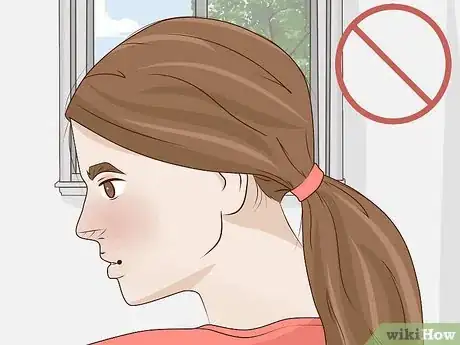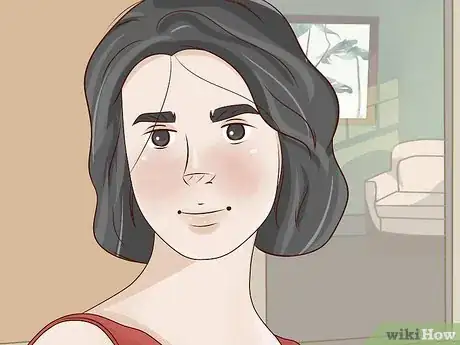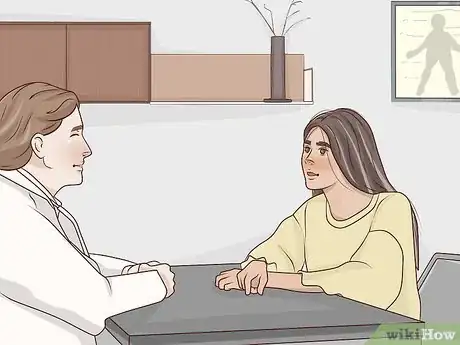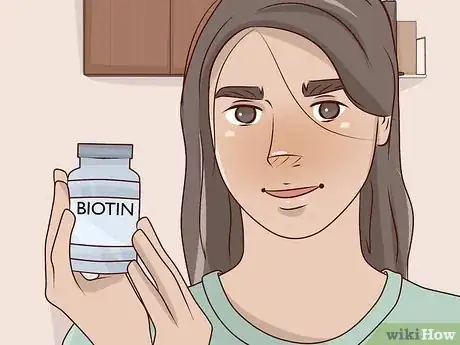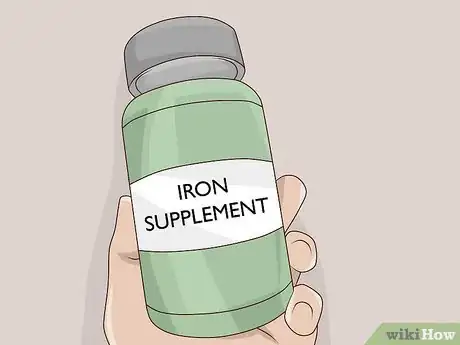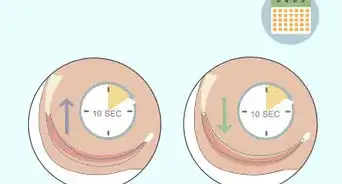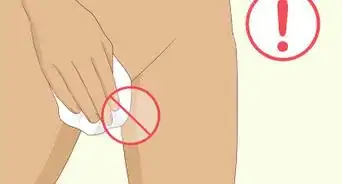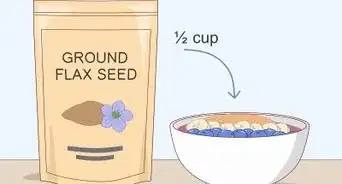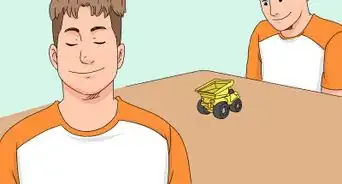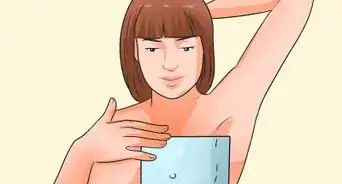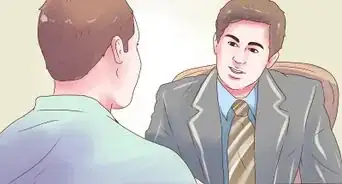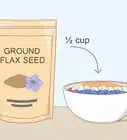This article was medically reviewed by Luba Lee, FNP-BC, MS and by wikiHow staff writer, Jennifer Mueller, JD. Luba Lee, FNP-BC is a Board-Certified Family Nurse Practitioner (FNP) and educator in Tennessee with over a decade of clinical experience. Luba has certifications in Pediatric Advanced Life Support (PALS), Emergency Medicine, Advanced Cardiac Life Support (ACLS), Team Building, and Critical Care Nursing. She received her Master of Science in Nursing (MSN) from the University of Tennessee in 2006.
There are 16 references cited in this article, which can be found at the bottom of the page.
This article has been viewed 9,440 times.
You have enough stress trying to adjust to life with a new baby. The last thing you need is for your hair to start coming out. And yet, postpartum hair loss is a natural (and totally normal) product of hormone shifts after pregnancy. While you were pregnant, your hormones promoted hair growth and actually prevented shedding. However, now that you've given birth to that little bundle of joy, those hormones have shifted, and now you're shedding all the hair you would've shed while you were pregnant—all at once. Eating healthy, staying active, taking time to rest, and taking vitamins and supplements as necessary can help minimize your hair loss. At the same time, you may need to switch hair care products or even get a new haircut to help your hair look its best while you're dealing with postpartum hair loss. Within a few months, your hair will go back to looking about the same as it did before you were pregnant.[1]
Steps
Adjusting Your Diet
-
1Try eating eggs for breakfast to help strengthen your hair. Eggs have plenty of protein and are rich in omega-3 fatty acids, which your body needs to grow strong, healthy hair. While you may not have time to make yourself a big breakfast every morning, you may be able to hard-boil eggs in advance so you can grab 1 or 2 in the morning to eat along with some fresh fruit or a light salad.[2]
- You might also try microwaveable egg scrambler cups. Simply crack an egg into the cup with the other ingredients and throw it in the microwave for a minute to cook the egg.
-
2Include foods with protein and iron in every meal to lessen hair loss. Hair loss can be a symptom of a protein or iron deficiency. On the other hand, eating foods with significant amounts of protein and iron strengthens your hair and may help keep your postpartum hair loss to a minimum. Foods you should eat regularly include:[3]
- Lean meats
- Poultry
- Quinoa
- Lentils
- Spinach
- Almonds
Advertisement -
3Add fish to restore your fatty acid levels. Fatty fish, including salmon, mackerel, sardines, and albacore tuna, are high in omegas, particularly omega-3 fatty acids. Fatty acids help your body build strong, healthy hair. Try to eat fish at least twice a week.[4]
- Avoid fish that are potentially high in mercury, including mackerel. Instead, stick to fish that are typically lowest in mercury, such as salmon and canned light tuna.[5]
-
4Promote hair growth with plenty of fruits and vegetables. Fruits and vegetables are rich in flavonoids and antioxidants that protect your hair follicles. They can help your hair grow stronger and prevent it from breaking as well as encourage new hair growth.[6]
- Try to include at least one serving (about the size of your fist) of both fruits and vegetables with every meal. Fruits and vegetables are also good to eat if you want a snack between meals.
-
5Avoid crash dieting to minimize hair loss. Even though you may be anxious to get rid of that baby weight, strict diets also limit the nutrients you ingest, which can make your postpartum hair loss even worse. Try to eat mainly the same types of foods you ate while you were pregnant.[7]
- Be especially cautious with any sort of diet that requires you to eliminate a particular type of food from your diet. That type of food may cause weight gain, but it may also contain nutrients your postpartum body needs.
Warning: Restrictive diets can damage your health, especially after you've given birth. Talk to your doctor before starting any new diet regimen, particularly if you're breastfeeding.
Caring for Your Hair and Scalp
-
1Massage a little peppermint oil into your scalp before shampooing. Studies have shown that peppermint oil can naturally boost hair growth.[8] Next time you shower, mix a few drops of peppermint oil into some almond or olive oil and massage it into your scalp. Then, shampoo your hair as you normally would.
- Other essential oils, such as thyme, rosemary, lavender, and cedarwood, may also help prevent or treat hair loss.[9]
- Always dilute peppermint oil and other essential oils with a carrier oil (such as almond, jojoba, grapeseed, or olive oil) before applying them to your hair or skin. Undiluted essential oils can cause irritation.
-
2Keep shampooing your hair as normal. When you look down in the tub or sink and see snarls of hair, it can be tempting to skip shampooing as often as possible. After all, with a new baby, it's not as though you have a lot of time to wash your hair anyway. However, your normal shampoo routine is not what is causing you to shed.[10]
- It's a good idea to switch to a gentler shampoo, one with a lighter formula that won't weigh your hair down. You might also look for a shampoo formulated for fine, thin hair to help add volume. Avoid shampoos that contain harsh ingredients, such as sulfates and parabens.
- Massage your scalp gently as you wash your hair to keep it healthy and help stimulate hair growth.
- Unless your hair is very oily, you probably don’t need to wash it every day. While over-shampooing your hair doesn’t cause hair loss, it can cause your hair to dry out and break more easily.[11]
- Concentrate the shampoo on your scalp to get rid of excess oils and dirt without overdrying the ends of your hair.
-
3Invest in a quality, gentle hairbrush to avoid breakage. If you're worried about too much of your hair snapping or getting tangled in the bristles of your old brush, it might be time for a new one. Choose a brush with softer bristles that are further apart to help prevent breakage.[12]
- If you use a comb more than a brush, look for a wide-tooth comb that will glide through your hair to gently detangle it without promoting shedding.
Tip: Try spraying a light detangler on your hair before brushing or combing it.
-
4Avoid arranging your hair in tight hairstyles to minimize stress on your hair. Pulling your hair into tight ponytails or cornrow braids or sewing in a weave puts additional stress on your hair and can cause it to weaken or break. If you need to pull your hair back to get it out of your face or keep it out of the way, try a loose ponytail with a soft scrunchy instead of an elastic hair tie.[13]
- A thick cloth or cloth-covered headband will also keep your hair out of your face without putting any additional stress on it.
- When you go out, a stylish floppy hat can help you manage your hair while also covering up any thin spots that you might be self-conscious about.
-
5Add volume to your hair with mousse. Mousse is one hair product that helps lock in your hair's moisture and boosts the volume in your hair, making it appear fuller. Avoid using mousse too close to your scalp, as it can make your hair look oily or dirty. The same thing will happen if you use too much. A dollop of mousse in your palm is all you need to work through your hair.[14]
- When you're trying to deal with hair loss, you might turn to hair products to arrange your hair in an attempt to cover up any thinning spots. However, many hair products will actually weigh down your hair and make it look thinner. They'll also dry out your hair, making it prone to additional breakage.
-
6Choose a shorter, more low-maintenance hairstyle if you have long hair. Changing your hairstyle or going with a shorter 'do can help disguise the appearance of postpartum hair loss. Shedding will also likely be less noticeable than it would be if you had longer hair.[15]
- Shorter hair is also easier to style and take care of, so you'll always look your best even while keeping up with the demands of a newborn.
- If you’d rather keep your hair long, trim it regularly to keep it looking healthy and minimize breakage and split ends.
Tip: A wide, bright-colored headband or bandana can cover up your thinning hair and control shedding while also looking stylish.
-
7Talk to your doctor about taking minoxidil if your hair doesn't grow back. With postpartum hair loss, the hair you shed will eventually grow back. However, it is possible that your hair may regrow more slowly in some areas than you'd like it to. Minoxidil (Rogaine) may be able to help.[16]
- Minoxidil is a lotion that you rub into your scalp. It helps stimulate natural hair growth.
Warning: Don't use minoxidil or similar products if you're breastfeeding. Talk to your doctor about ways you can stimulate hair growth that won't present a risk to your nursing infant.
-
8Ask your doctor about a hormone imbalance if your hair loss is severe. While some postpartum hair loss is normal, in some cases it can be a sign of an underlying medical issue, such as postpartum thyroid disease.[17] If you’re concerned about the amount of hair you’re losing, talk to your doctor about doing tests to find out if something more serious is going on.
- If you are diagnosed with a postpartum hormone imbalance, don’t be alarmed. Most of these conditions eventually resolve as your body readjusts after pregnancy. Your doctor will work with you to monitor your condition and prescribe medications if necessary.[18]
Taking Vitamins and Supplements
-
1Continue to take prenatal supplements. Prenatal vitamins ensure that your baby will have the nutrition they need as they’re growing in the womb. After your baby is born, though, continuing to take prenatal vitamins keeps you from dropping to deficiency levels in those same vitamins.[19]
- Prenatal supplements also include vitamins that promote hair growth and keep the hair that you have healthy so that it continues to grow thick and strong.
-
2Promote hair regrowth with biotin and vitamin C. These vitamins are frequently featured in supplement combinations designed to improve the condition of your hair. Biotin helps stimulate hair growth and vitamin C boosts your immune system, which will help you combat stress and other issues that could increase your hair loss.[20]
- Biotin is a B vitamin (B7, to be exact), so taking a vitamin B complex vitamin will also help stimulate hair growth and minimize shedding.
Warning: If you're breastfeeding, talk to your doctor before taking any supplements to make sure they won't harm your baby.
-
3Add an iron supplement if your iron levels are low. Iron levels can plummet after a pregnancy and iron deficiency may exacerbate your postpartum hair loss. If you have iron deficiency, oral supplements may help decrease the amount of hair you're shedding.[21]
- Your doctor may not recommend additional iron supplements unless you are anemic. Generally, your body absorbs iron better if you get it from food rather than taking a supplement.
- If your doctor does recommend an iron supplement, you'll typically only take it for a few weeks until your iron levels are restored. After that, you should be able to get all the iron you need from food.
Tip: Vegetarians and vegans require almost twice as much iron as those who eat meat. If you have a vegetarian or vegan diet, your doctor may have you take an iron supplement.
Warnings
- Watch out that your shedding hair doesn't fall on your baby. A strand could wrap around your baby's toe, finger, or other body part and form a "hair tourniquet" that cuts off your baby's circulation.[23]⧼thumbs_response⧽
References
- ↑ https://www.health.harvard.edu/a_to_z/telogen-effluvium-a-to-z
- ↑ https://www.parents.com/pregnancy/my-body/postpartum/hair-loss-after-baby-regrowing-tips/
- ↑ https://www.getthegloss.com/article/how-to-cope-with-post-partum-hair-loss
- ↑ https://flo.health/being-a-mom/recovering-from-birth/postpartum-problems/tips-to-tackle-postpartum-hair-loss
- ↑ https://www.heart.org/en/healthy-living/healthy-eating/eat-smart/fats/fish-and-omega-3-fatty-acids
- ↑ https://americanpregnancy.org/pregnancy-health/hair-loss-during-pregnancy/
- ↑ https://www.health.harvard.edu/a_to_z/telogen-effluvium-a-to-z
- ↑ https://www.ncbi.nlm.nih.gov/pmc/articles/PMC4289931/
- ↑ https://www.ncbi.nlm.nih.gov/pubmed/9828867
- ↑ https://www.aad.org/managing-tips
- ↑ https://www.aad.org/public/everyday-care/hair-scalp-care/hair/healthy-hair-tips
- ↑ https://www.getthegloss.com/article/how-to-cope-with-post-partum-hair-loss
- ↑ https://flo.health/being-a-mom/recovering-from-birth/postpartum-problems/tips-to-tackle-postpartum-hair-loss
- ↑ https://www.getthegloss.com/article/how-to-cope-with-post-partum-hair-loss
- ↑ https://www.health.com/condition/pregnancy/postpartum-hair-loss
- ↑ https://www.health.harvard.edu/a_to_z/telogen-effluvium-a-to-z
- ↑ https://www.ncbi.nlm.nih.gov/pmc/articles/PMC4227325/
- ↑ https://www.mayoclinic.org/diseases-conditions/postpartum-thyroiditis/diagnosis-treatment/drc-20376680
- ↑ https://www.whattoexpect.com/first-year/postpartum-health-and-care/postpartum-hair-loss/
- ↑ https://flo.health/being-a-mom/recovering-from-birth/postpartum-problems/tips-to-tackle-postpartum-hair-loss
- ↑ http://www.ijdvl.com/article.asp?issn=0378-6323;year=2010;volume=76;issue=2;spage=103;epage=115;aulast=Kaimal
- ↑ https://www.health.harvard.edu/a_to_z/telogen-effluvium-a-to-z
- ↑ https://www.aad.org/new-moms








